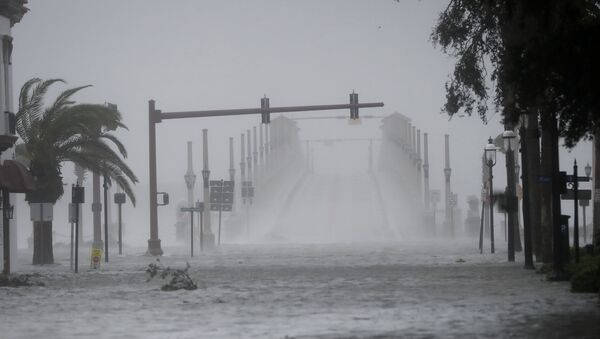A 58-year-old woman from St. Lucie County, Florida, is being called the first US casualty of the storm. She suffered a heart attack at a time when winds were gusting at 68 mph, preventing emergency crews from traveling. By the time emergency services reached her, she had died.
The Daytona Beach fire department has also suspended operations due to wind, the Weather Channel reported Friday afternoon.
The storm, downgraded to a category 3 hurricane late October 6, has been making its slow way up the Florida coast at about 12 mph, bringing sustained winds of up to 120 mph and storm surges expected to cause widespread destruction in Florida, Georgia, South Carolina and North Carolina.
In a Friday afternoon update from the National Hurricane Center, National Hurricane Center Director Rick Knabb said, "Life threatening flooding is occurring in the storm surge area." He commented that the surge wasn’t slow rising, but coming in "with great force."
Wind gusts as high as 107 mph were reported from Cape Canaveral, Florida, roughly where the storm began its turn north. The eye of the storm may never actually make landfall, storm watchers say, but the wind and water churned up by its eyewall will do plenty of damage as it continues to spin north-northwest. The storm is expected to turn more strongly north and spare the coast a direct hit. If it instead shifts west, the destruction in its wake could be expected to be much worse.
The storm surge is often the most destructive part of a hurricane, and the power of Matthew’s surge is already being seen in Daytona, St. Augustine and points north. Twitter users are showing that the St. Augustine seawall has been completely submerged.St Augustine sea wall has vanished under the waves.
— Jeff Goodell (@jeffgoodell) October 7, 2016
The National Weather Service is warning that the storm surge could be stronger than the one that wreaked havoc on the New Jersey shore in 2012.
In Brevard, Flagler, Indian River, St. John and Volusia counties, more than half of electrical customers have lost power, according to Florida Power and Light.
South Florida was already spared much of the storm’s consequences when it tacked slightly north, though the Miami Herald reports that more than 100,000 people in the southern counties of Miami-Dade, Broward and Palm Beach lost power Thursday and into Friday. As of 1 p.m. Friday, the storm was 25 miles east-northeast of Ormond Beach, Florida.
— Ashley Hollander (@AshleyANjax) October 7, 2016
Matthew is moving into territory usually spared the worst of Florida’s storm season. Jacksonville has not been under a hurricane warning in 17 years, The Weather Channel reports; now, the city is preparing for a potentially devastating hit. The northern Florida city of 868,000 is the largest population center in the hurricane’s path.
Florida Governor Rick Scott minced no words in addressing populations in storm-threatened areas the morning of October 6, saying the storm would be “catastrophic.”
If you’re in an evacuation area, “get out,” he said "Do not surf. Do not go to the beach. This will kill you."
A hurricane warning from the National Hurricane Center extends nearly as far as North Carolina, with a tropical storm warning covering that state's Outer Banks, as well as Albemarle and Pamlico Sounds.
South Carolina is also preparing for a major hit. “This is going to hurt,” South Carolina Governor Nikki Haley said at an October 7 press conference. "We are looking at major storm surges, major winds, major wet grounds that could include flooding like we saw last year."
Haley has urged residents to evacuate barrier islands and coastal areas.
— Mike Lovecchio (@mikelovecchio) October 7, 2016
US President Barack Obama has declared states of emergency in Florida, Georgia and South Carolina to expedite federal aid to the storm-struck states.
Before arriving in Florida, Matthew cut a tragic swathe across Haiti, killing over 800 people, according to a Reuters tally of official death tolls, and thousands have been left homeless. Estimates of the death toll on the island nation jumped overnight, as services began to reach parts of the island cut off after the storm rolled through on October 4, with 145 mph winds.

The death toll is particularly high on Haiti’s southwest coast, the BBC reports, which took a direct hit. At least one major southern town, Jeremie, has been almost completely destroyed. Some areas remain inaccessible because of floodwaters, and only over the next four or five days do officials expect to be able to put together a more complete picture of the death and damage left in the storm’s wake.
Four people were reported dead in the Dominican Republic October 4. The storm went on to hit the Bahamas two days later, with no fatalities reported.




